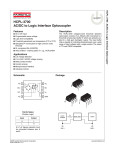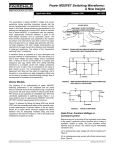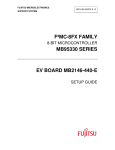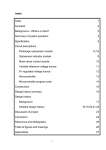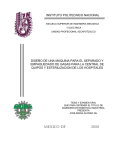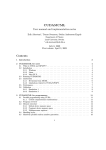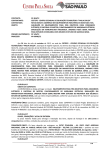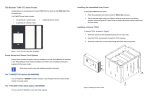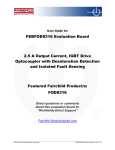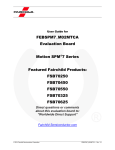Download AN-7012 FPF2100/7 Evaluation Board User's Guide
Transcript
www.fairchildsemi.com AN-7012 FPF2100/7 Evaluation Board User’s Guide Contents Evaluation Board Description.........................................................................................................................2 Contents of Evaluation Kit.........................................................................................................................2 Evaluation Board Specifications.................................................................................................................2 Photo of Evaluation Board.........................................................................................................................3 Evaluation Board Schematic......................................................................................................................3 Setup and Test Procedure..............................................................................................................................4 Test Results................................................................................................................................................4-5 Evaluation Board Bill of Materials (BOM).........................................................................................................6 © 2005 Fairchild Semiconductor REV. 1.0.0 6/30/05 www.fairchildsemi.com AN-7012 FPF2100/7 Evaluation Board User’s Guide Evaluation Board Description Monitoring the FLAGB The FPF2100/7 board is an Evaluation Module (EVM) for the Fairchild Semiconductor FPF2100/1/2/3/4/5/6/7 smart load switches family. The FPF2100/7 family contains a 0.125Ω P-channel MOSFET with controlled turn-on, fast turn-off, thermal shutdown, under voltage lock out, and current limit. The current limit is guaranteed for 200 mA for the FPF2100/1/2/3 and 400 mA for the FPF2104/5/6/7. The operating voltage range is 1.8V to 5.5V. The EVM board provides access for monitoring all pins, and simulates the fault conditions as they might occur in a real application. This is accomplished by changing the states of the ON pin, input voltage, and output current and voltage. See Figure 1 page 2, for a detailed view of the board. The status of the FLAGB pin can be monitored via TP1 either by probing directly the FLAGB pin or by lighting a small LED. For this purpose J3 needs to be set as shown in Figure1. For parts without Auto-Restart the LED stays lit in current limit conditions until the SW2 switch is toggled. For parts with Auto-Restart the LED will light only as long as the pushbutton switch (SW1) is being held down. Current-Limit • Using SW2 for manual ON/OFF switching. This can be used for resetting a part without Auto-Restart in latch off mode. • Using External ON terminal (TP4) for driving the ON pin with an external signal. • Using J2 for setting the ON pin polarity. Set J2 as shown in Figure 1. The output current can be sensed with a current probe by removing the R3 shunt and soldering a loop across it. The FPF2100/7 EVM board has a nominal load in normal operation. By momentarily pushing the SW1 switch the load switch will be put in an overcurrent condition. In addition, the overcurrent condition may be triggered by an external signal through the external. over-current terminal (TP3). The three load conditions are as follows: • Nominal load: Normal operation with R1 = 500Ω and C1 = 0.1µF load. • Moderate overcurrent: Output is loaded with a 2.2Ω resistor (J2 in position 2). • Hard short: Output is connected directly to ground (J2 in position 1). Extra space has been provided on the board next to R1 and C1 for the user to mount any desired load for further experiments. 2 ON Pin The status of the ON pin can be monitored through TP2. Referring to the part number and test conditions, three mechanisms have been employed to change the ON pin condition: Contents of Evaluation Kit • • • • Evaluation Board Cable CD FPF2100/7 sample parts Evaluation Board Specifications The Evaluation Module has test points for convenient access to the all pins and jumpers for setting the various load conditions along with switches for toggling the ON pin and configuring the ON pin polarity. The board is a stand alone unit for testing all functions. The operation input voltage range is 1.8V-5.5V. Board dimensions are 1.75 x 2.35 inches. REV. 1.0.0 6/30/05 APPLICATION NOTE AN-7012 Evaluation Board J1: Current Limit Conditions 1. Hard short (VOUT = 0V) 2. Moderate over current (VOUT = 2 x IOUT) SW1: Internal OverCurrent Condition Set J1 for selecting conditions Sensing Output Current Remove the R3 = 0Ω and sense the output current by soldering a loop across it TP3: External OverCurrent Using a function generator, vary the pulse width to test the TBLANK and TRESTART functions through test point TP3 J2: Configuring the ON Pin Polarity 1. Active LO FPF2101 and FPF2105 2. Active HI FPF2100, 02, 03, 04, 06, 07 J3: FLAGB Position A: Using LED B: Activating TP1 TP4: External ON Control the ON/OFF state of switch by using a Function Generator TP1: FLAGB Pin (First put J3 in position 1 ) SW2: ON/OFF Switch Toggling SW2 will releases the Load switch from latch-off mode TP2: On Pin Figure 1. FPF2100/7 EVM Board Evaluation Board Schematic VIN VCC VOUT 1 1 ON/OFF Switch D1 BZX84C10/SOT CIN1 10UF SW2 R9 10K 5 U2B U3A 5 TP4 3 1 TP2 1 7 6 2 NC7WZ86 R8 50 R10 10K VCC J2 GND 3 ON Vout 4 FLAGB TP1 R5 2.2 C1 0.1UF R1 499 FPF210X NC7WZ32K8 Ext. ON 2 1 C3 0.1UF Vin J1 R3 0 U1 1 1 VCC C4 0.1UF Q2 FDC645N J3 VCC QTLP600CR D2 Q1 FDC645N R4 150 R2 ON Pin Polarity 100K VCC 1 Over-Current Condition 4 0.1UF C2 U2A 1 7 SW1 2 3 2 R6 100K NC7WZ32K8 1 TP3 Ext. OverCurrent R7 50 Figure 2. FPF2100/7 EVM Board Schematic REV. 1.0.0 6/30/05 3 AN-7012 APPLICATION NOTE Evaluation Board Block Diagram Battery VIN VOUT GND ON SW2: ON/OFF switch TP4: ext. signal 1. Hard short FLAGB 2. Moderate short ON Pin SW1 J2: ON pin polarity TP2 ON pin test point LED or TP1 Overcurrent Cond. Indecator Ext. signal TP3 Short Circuit System RC Load (Overcurrent cond.) Figure 3. FPF2100/7 EVM Board Block Diagram Setup and Test Procedure Test Results The following equipment is recommended for testing: 1. Measuring tBLANK and tRESTART of FPF2100 (Figures 4 to 6) • • • • • This test has been designed to demonstrate the FPF2100 behavior while the output is in a moderate short for 40ms, 170ms, and 180ms. The board setup is described in part 2.0 of this document. A four-channel oscilloscope Current probe One adjustable power supply, 0V-6V@6A Voltmeter Function generator with burst function single pulse The EVM board is a suitable platform for testing the main electrical characteristics of the FPF2100/7 products. Various tests such as under voltage lock out, ON input logic voltage, Current Limit value and all dynamic characteristics of the load switch can be performed by using two methods for changing the output, and ON pin condition. The first method is by changing the SW1 or SW2 switches manually on the board, and the second by applying an external signal pulse through TP3 or TP4 for more detailed observation. Here are two examples of test setup: Figure 4 shows the FPF2100 is in an overcurrent condition for 40ms. In this case the load switch limits theoutput current to the Overcurrent Limit value for tBLANK time. Since the short stays longer than blanking time, the load switch turns off for tRESTART time and the FLAGB pin activates. 1. Measuring tBLANK and tRESTART value (Figures 4 to 6) • Power up the board with VIN = 3.3V. • Remove the current sense resistor (R3) and solder a small wire across R3 in order to use oscilloscope current probe. • Put the shunt of J3 in position 2, this will connect the FLAGB pin to TP1. • Put the shunt of J1 to position 2 for moderate overcurrent. • Connect an external pulse from a function generator to TP3. For better triggering the events on the oscilloscope, a single burst pulse is recommended. 2. Current Limit Response Time at moderate short (Figure 7) Power up the board with VIN = 3.3V Put the shunt of J2 in position 1 Put the SW2 in position LO Put the shunt of J1 in position 2 Connect an external pulse from a function generator to TP4. For better triggering the events on the oscilloscope, a single burst pulse is recommended • Push down the pushbutton switch (SW1) while pulsing the TP4 • • • • • 4 Figure 4. tBLANK < Overcurrent = 40ms < tBLANK + tRESTART Figure 4 Ch1 = External overcurrent signal has been applied to gate of a NMOS Ch2 = IOUT (200mA/div) Ch3 = VOUT Ch4 = FLAGB REV. 1.0.0 6/30/05 APPLICATION NOTE Figure 5 shows the overcurrent condition stays longer than the tRESTART time. The load switch turns on after tRESTART time has expired and senses the overcurrent condition again. The constant current limit will be supplied to the output for tBLANK. At the end of the second tBLANK, the short was removed from the line and the load switch is in normal operation. AN-7012 Figures 5 and 6 Ch1 = External overcurrent signal has been applied to gate of a NMOS Ch2 = IOUT (200mA/div) Ch3 = VOUT Ch4 = FLAGB 2. Current Limit Response Time Test (Figure 7) This test has been designed to measure the load switch’s response time while the output is loaded by a small resistor, 2.2Ω to GND (moderate short). Figure 7 shows response when the input voltage is connected to 3.3V and a moderate short is applied to the output while the ON pin is triggered HI. From the waveforms, it can be seen that the delay between ON pin triggering and output current is about 27µs. Figure 5. tBLANK + tRESTART < Overcurrent = 160ms < 2x tBLANK + tRESTART Figure 6 shows that the overcurrent condition stays longer than one cycle of tBLANK + tRESTART. The values of tBLANK and tRESTART can be measured from channel 2 of this figure, where tBLANK =10ms and tRESTART =150ms. Figure 7. Current Limit Response Time Test Figure 7 Ch1 = VIN=3.3V Ch2 = IOUT (200mA/div) Ch3 = VON Figure 6. 2x tBLANK + tRESTART < Overcurrent = 80ms REV. 1.0.0 6/30/05 5 AN-7012 APPLICATION NOTE Table 1. Evaluation Board Bill of Materials (BOM) Item Quantity Reference Part Mfg 1 1 CIN1 10UF Any 2 4 C1, C2, C3, C4 0.1UF Any 3 1 D1 BZX84C10 SOT Fairchild 4 1 D2 QTLP600CR Fairchild 5 1 J1 Dual Jumper 2mm Any 6 2 J2, J3 Conn Header 2mm Single Any 7 2 Q1, Q2 FDC645N Fairchild 8 1 R1 499 Any 9 2 R2, R6 100K Any 10 1 R3 0 Any 11 1 R4 150 Any 12 1 R5 2.2 Any 13 2 R7, R8 50 Any 14 2 R9, R10 10K Any 15 1 SW1 Pushbutton-SPST Any 16 1 SW2 SPDT Any 17 4 TP1, TP2, TP3, TP4 Test Point Any 18 1 U1 FPF2100/1/2/3/4/5/6/7 Fairchild 19 1 U2 NC7WZ32K8 Fairchild 20 1 U3 NC7WZ86 Fairchild Author Kamil Madoo Application Engineer Fairchild Semiconductor International 6 REV. 1.0.0 6/30/05 TRADEMARKS The following are registered and unregistered trademarks Fairchild Semiconductor owns or is authorized to use and is not intended to be an exhaustive list of all such trademarks. ACEx™ FAST® ActiveArray™ FASTr™ Bottomless™ FPS™ Build it Now™ FRFET™ CoolFET™ GlobalOptoisolator™ CROSSVOLT™ GTO™ DOME™ HiSeC™ EcoSPARK™ I2C™ E2CMOS™ i-Lo™ EnSigna™ ImpliedDisconnect™ FACT™ IntelliMAX™ FACT Quiet Series™ Across the board. Around the world.™ The Power Franchise® Programmable Active Droop™ ISOPLANAR™ LittleFET™ MICROCOUPLER™ MicroFET™ MicroPak™ MICROWIRE™ MSX™ MSXPro™ OCX™ OCXPro™ OPTOLOGIC® OPTOPLANAR™ PACMAN™ POP™ Power247™ PowerEdge™ PowerSaver™ PowerTrench® QFET® QS™ QT Optoelectronics™ Quiet Series™ RapidConfigure™ RapidConnect™ μSerDes™ SILENT SWITCHER® SMART START™ SPM™ Stealth™ SuperFET™ SuperSOT™-3 SuperSOT™-6 SuperSOT™-8 SyncFET™ TinyLogic® TINYOPTO™ TruTranslation™ UHC™ UltraFET® UniFET™ VCX™ Wire™ DISCLAIMER FAIRCHILD SEMICONDUCTOR RESERVES THE RIGHT TO MAKE CHANGES WITHOUT FURTHER NOTICE TO ANY PRODUCTS HEREIN TO IMPROVE RELIABILITY, FUNCTION OR DESIGN. FAIRCHILD DOES NOT ASSUME ANY LIABILITY ARISING OUT OF THE APPLICATION OR USE OF ANY PRODUCT OR CIRCUIT DESCRIBED HEREIN; NEITHER DOES IT CONVEY ANY LICENSE UNDER ITS PATENT RIGHTS, NOR THE RIGHTS OF OTHERS. LIFE SUPPORT POLICY FAIRCHILD’S PRODUCTS ARE NOT AUTHORIZED FOR USE AS CRITICAL COMPONENTS IN LIFE SUPPORT DEVICES OR SYSTEMS WITHOUT THE EXPRESS WRITTEN APPROVAL OF FAIRCHILD SEMICONDUCTOR CORPORATION. As used herein: 2. A critical component is any component of a life 1. Life support devices or systems are devices or support device or system whose failure to perform can systems which, (a) are intended for surgical implant into be reasonably expected to cause the failure of the life the body, or (b) support or sustain life, or (c) whose support device or system, or to affect its safety or failure to perform when properly used in accordance with instructions for use provided in the labeling, can be effectiveness. reasonably expected to result in significant injury to the user. PRODUCT STATUS DEFINITIONS Definition of Terms Datasheet Identification Product Status Definition Advance Information Formative or In Design This datasheet contains the design specifications for product development. Specifications may change in any manner without notice. Preliminary First Production This datasheet contains preliminary data, and supplementary data will be published at a later date. Fairchild Semiconductor reserves the right to make changes at any time without notice in order to improve design. No Identification Needed Full Production This datasheet contains final specifications. Fairchild Semiconductor reserves the right to make changes at any time without notice in order to improve design. Obsolete Not In Production This datasheet contains specifications on a product that has been discontinued by Fairchild semiconductor. The datasheet is printed for reference information only. Rev. I16








